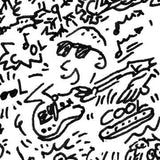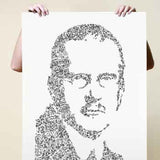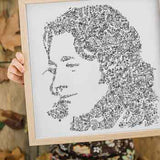B.P stands for Baden Powell and Be Prepared !
Lord Baden Powell is well known for beeing the founder of for the Scout movement.
He is better known by his initials B.P which are also used in the Scout motto
So be prepared to his biographical drawing with plenty of fun facts !"Be Prepared !".
To discover his life, how he got the idea of scouting. The print of the portrait can be found here for making a great gift to someone you like
2. He grew up in a scouting Family

Baden Powell grew up in Paddington (near London) in a large family with brothers and sisters. His dad died when he was . His mother, Henrietta Grace Smyth was strong woman. She wanted all her children to succeed :
- Older brother Warington Powell help in the founding of Sea scouting.
- Younger sister Agnes Smyth Baden-Powell establishing the Girl Guide Movement
- Younger brother Baden Baden-Powell brought flying-based activities into Scouting.
Robert played music, was an artist and spent his holidays with siblings on camping,explorations and canoeing.

He learned his first scouting skills and was more interrested into hunting rabbits, and avoiding teachers at the prestigious "Charter House".

3. BP Joined the Army
As he spent most of his time exploring the woods behind school compare to the time studying in school, he wasn't accepted at University. In 1876 Baden-Powell joined the British Army and a Cavalry Regiment.

Sent in British colonies, he spent his time henancing his military scouting skills. He was particularily amazed by the Zulu scouts in South Africa.

As the scouts had to explore and survive, he met the American scout Mr Russell Burnham, specialist in Woodcrafting and surviving technics. He also got the idea of the very usefull campaign hat and the practical use of neckerchief.

4. Mafeking, the first experiment
Baden-Powell was engaged in South Africa in military actions and asked to maintain a mobile mounted force on the frontier with the Boer (dutch colons), he amassed stores and a garrison at Mafeking.

Mafeking siege started when the city was was surrounded by a Boer army of 8,000 men. The garrison held out 217 days in part thanks to cunning deceptions and strategy tricks many devised by Baden-Powell : Fake minefields and non-existent barbed wire.

The Mafeking Cadet Corps boys stood guard, carried messages, assisted in hospitals, helping to setting up fake weapons.freeing grown men to fight.
BP was really impressed with both their courage and the how they performed well their tasks. They are the subject of the first chapter of his book "Scouting for Boys".

5. Scouting for young boys in U.K
Back in U.K, the military training manual "Aids to Scouting" had become a best-seller, used by teachers and youth organisations. B P think about going further and re-write "Aids to Scouting" for a youth readership.

Time to make some practice, he start enrolling young lads of poor suburbs of London : Join scouting !

6. First camp on Brownsea Island and the Kudu horn
In summer 1907 he held the first scout camp on Brownsea Island to test out his ideas about scouting. Twenty boys attended the camp in the Dorset Island.

He didnt forgot to take his Kudu Horn to celebrate this first event.


7. Worldwide scout Movement : Unity and Fraternity
Boys and girls spontaneously formed Scout troops and the Scouting Movement had inadvertently started, first as a national, and soon an international phenomenon. BP sister helped a lot for the guide movement, he was also assisted by his wife Olave and other brothers to make it big.

Baden-Powell was acclaimed Chief Scout of the World and also Baronet by George the fifth in 1921. He took the name Baron Baden Powell of Gilwell, a place in the County of Esse that became a national places dedicated for scouts.

He left many symbols to the world : the scouting symbol first wich is composed of a Fleur de Lys, used in former rose compass to indicate the North. The rope is the symbol of unity.

Baden-Powell died on 8 January 1941, and is buried in Kenya. His gravestone bears a circle with a dot in the centre, which is the trail sign for "Going home".
![Baden-Powell died on 8 January 1941, and is buried at St Peter's Cemetery in Nyeri.[57] Lord Erroll, of the Happy Valley set, was in his funeral procession,[58] just prior to being murdered, on 24 January 1941.[59] His gravestone bears a circle with a dot in the centre "ʘ", which is the trail sign for "Going home", or "I have gone home".](http://cdn.shopify.com/s/files/1/0250/4160/0597/files/baden-powell-grave-tombstone-going-home_480x480.jpg?v=1591708688)
He aslso left for us the very significant Scout sign, composed of the three promises of the Scout
- Duty to God and country
- Duty to other people
- Duty to self.
The joined thumb and little fingers joined together represent the unity of the Scouting movement and usually the brotherhood and chivalry : the strong protects the weak.










